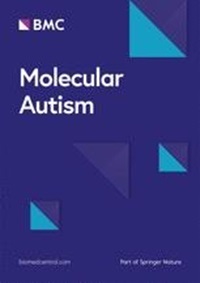Detection of autism spectrum disorder-related pathogenic trio variants by a novel structure-based approach
IF 6.3
1区 医学
Q1 GENETICS & HEREDITY
引用次数: 0
Abstract
Glutamatergic synapse dysfunction is believed to underlie the development of Autism Spectrum Disorder (ASD) and Intellectual Disability (ID) in many individuals. However, identification of genetic markers that contribute to synaptic dysfunction in these individuals is notoriously difficult. Based on genomic analysis, structural modeling, and functional data, we recently established the involvement of the TRIO-RAC1 pathway in ASD and ID. Furthermore, we identified a pathological de novo missense mutation hotspot in TRIO’s GEF1 domain. ASD/ID-related missense mutations within this domain compromise glutamatergic synapse function and likely contribute to the development of ASD/ID. The number of ASD/ID cases with mutations identified within TRIO’s GEF1 domain is increasing. However, tools for accurately predicting whether such mutations are detrimental to protein function are lacking. Here we deployed advanced protein structural modeling techniques to predict potential de novo pathogenic and benign mutations within TRIO’s GEF1 domain. Mutant TRIO-9 constructs were generated and expressed in CA1 pyramidal neurons of organotypic cultured hippocampal slices. AMPA receptor-mediated postsynaptic currents were examined in these neurons using dual whole-cell patch clamp electrophysiology. We also validated these findings using orthogonal co-immunoprecipitation and fluorescence lifetime imaging (FLIM-FRET) experiments to assay TRIO mutant overexpression effects on TRIO-RAC1 binding and on RAC1 activity in HEK293/T cells. Missense mutations in TRIO’s GEF1 domain that were predicted to disrupt TRIO-RAC1 binding or stability were tested experimentally and found to greatly impair TRIO-9’s influence on glutamatergic synapse function. In contrast, missense mutations in TRIO’s GEF1 domain that were predicted to have minimal effect on TRIO-RAC1 binding or stability did not impair TRIO-9’s influence on glutamatergic synapse function in our experimental assays. In orthogonal assays, we find most of the mutations predicted to disrupt binding display loss of function but mutants predicted to disrupt stability do not reflect our results from neuronal electrophysiological data. We present a method to predict missense mutations in TRIO’s GEF1 domain that may compromise TRIO function and test for effects in a limited number of assays. Possible limitations arising from the model systems employed here can be addressed in future studies. Our method does not provide evidence for whether these mutations confer ASD/ID risk or the likelihood that such mutations will result in the development of ASD/ID. Here we show that a combination of structure-based computational predictions and experimental validation can be employed to reliably predict whether missense mutations in the human TRIO gene impede TRIO protein function and compromise TRIO’s role in glutamatergic synapse regulation. With the growing accessibility of genome sequencing, the use of such tools in the accurate identification of pathological mutations will be instrumental in diagnostics of ASD/ID.用一种基于结构的新方法检测与自闭症谱系障碍相关的致病三元组变体
谷氨酸能突触功能障碍被认为是自闭症谱系障碍(ASD)和智力障碍(ID)在许多人身上发展的基础。然而,鉴定导致这些患者突触功能障碍的遗传标记物却非常困难。基于基因组分析、结构建模和功能数据,我们最近确定了 TRIO-RAC1 通路参与了 ASD 和 ID 的研究。此外,我们还在 TRIO 的 GEF1 结构域中发现了一个病理性的新发错义突变热点。该结构域中与ASD/ID相关的错义突变会损害谷氨酸能突触的功能,并可能导致ASD/ID的发生。在TRIO的GEF1结构域中发现突变的ASD/ID病例数量正在增加。然而,准确预测这种突变是否对蛋白质功能有害的工具却很缺乏。在这里,我们利用先进的蛋白质结构建模技术来预测 TRIO GEF1 结构域中潜在的新致病突变和良性突变。我们生成了突变的 TRIO-9 构建体,并在有机培养的海马切片的 CA1 锥体神经元中进行了表达。我们使用双全细胞膜片钳电生理学方法检测了这些神经元中 AMPA 受体介导的突触后电流。我们还利用正交共免疫沉淀和荧光寿命成像(FLIM-FRET)实验验证了这些发现,并在 HEK293/T 细胞中检测了 TRIO 突变体过表达对 TRIO-RAC1 结合和 RAC1 活性的影响。实验测试了 TRIO 的 GEF1 结构域中被认为会破坏 TRIO-RAC1 结合或稳定性的错义突变,结果发现这些突变极大地削弱了 TRIO-9 对谷氨酸能突触功能的影响。与此相反,在我们的实验测试中,TRIO 的 GEF1 结构域中被认为对 TRIO-RAC1 的结合或稳定性影响最小的错义突变并没有损害 TRIO-9 对谷氨酸能突触功能的影响。在正交试验中,我们发现大多数被预测为破坏结合的突变显示出功能缺失,但被预测为破坏稳定性的突变并未反映出我们从神经元电生理数据中得出的结果。我们提出了一种方法来预测 TRIO GEF1 结构域中可能损害 TRIO 功能的错义突变,并在有限的实验中测试其影响。本文所采用的模型系统可能存在的局限性可在今后的研究中加以解决。我们的方法并不能证明这些突变是否会带来 ASD/ID 风险,也不能证明这些突变会导致 ASD/ID 发病的可能性。我们在此表明,基于结构的计算预测和实验验证相结合,可以可靠地预测人类 TRIO 基因中的错义突变是否会阻碍 TRIO 蛋白的功能并损害 TRIO 在谷氨酸能突触调控中的作用。随着基因组测序技术的日益普及,利用此类工具准确鉴定病理突变将有助于诊断 ASD/ID。
本文章由计算机程序翻译,如有差异,请以英文原文为准。
求助全文
约1分钟内获得全文
求助全文
来源期刊

Molecular Autism
GENETICS & HEREDITY-NEUROSCIENCES
CiteScore
12.10
自引率
1.60%
发文量
44
审稿时长
17 weeks
期刊介绍:
Molecular Autism is a peer-reviewed, open access journal that publishes high-quality basic, translational and clinical research that has relevance to the etiology, pathobiology, or treatment of autism and related neurodevelopmental conditions. Research that includes integration across levels is encouraged. Molecular Autism publishes empirical studies, reviews, and brief communications.
 求助内容:
求助内容: 应助结果提醒方式:
应助结果提醒方式:


